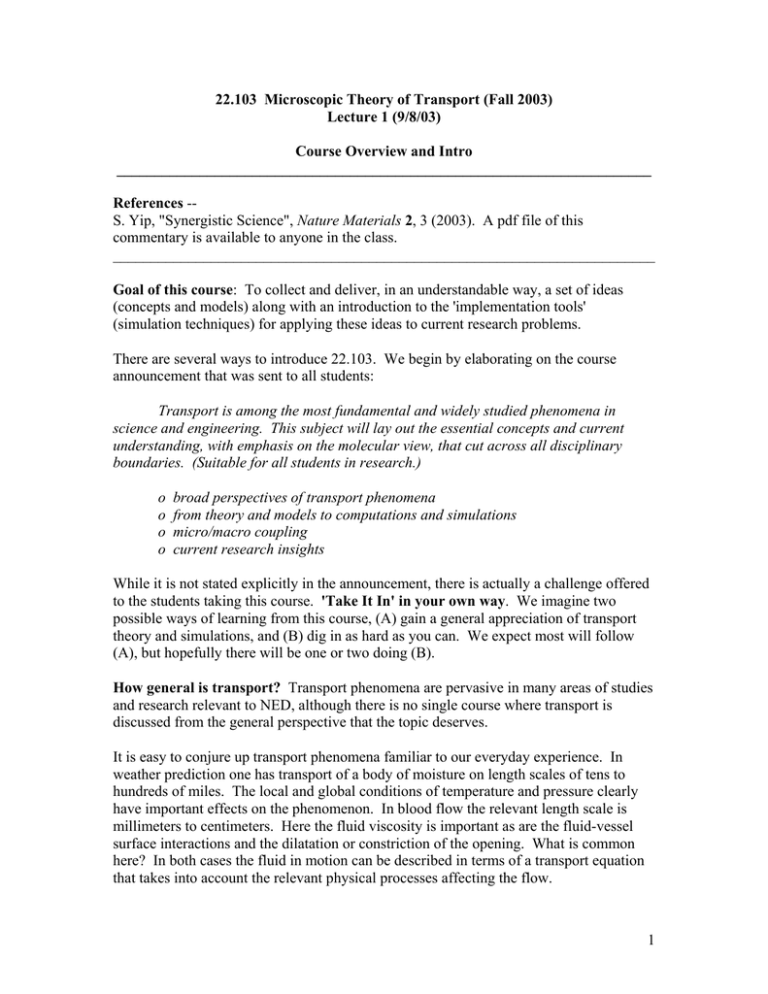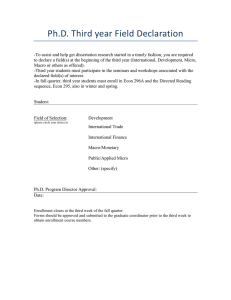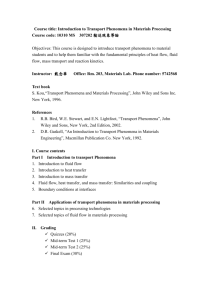22.103 Microscopic Theory of Transport (Fall 2003) Lecture 1 (9/8/03) _______________________________________________________________________
advertisement

22.103 Microscopic Theory of Transport (Fall 2003) Lecture 1 (9/8/03) Course Overview and Intro _______________________________________________________________________ References -S. Yip, "Synergistic Science", Nature Materials 2, 3 (2003). A pdf file of this commentary is available to anyone in the class. ________________________________________________________________________ Goal of this course: To collect and deliver, in an understandable way, a set of ideas (concepts and models) along with an introduction to the 'implementation tools' (simulation techniques) for applying these ideas to current research problems. There are several ways to introduce 22.103. We begin by elaborating on the course announcement that was sent to all students: Transport is among the most fundamental and widely studied phenomena in science and engineering. This subject will lay out the essential concepts and current understanding, with emphasis on the molecular view, that cut across all disciplinary boundaries. (Suitable for all students in research.) o o o o broad perspectives of transport phenomena from theory and models to computations and simulations micro/macro coupling current research insights While it is not stated explicitly in the announcement, there is actually a challenge offered to the students taking this course. 'Take It In' in your own way. We imagine two possible ways of learning from this course, (A) gain a general appreciation of transport theory and simulations, and (B) dig in as hard as you can. We expect most will follow (A), but hopefully there will be one or two doing (B). How general is transport? Transport phenomena are pervasive in many areas of studies and research relevant to NED, although there is no single course where transport is discussed from the general perspective that the topic deserves. It is easy to conjure up transport phenomena familiar to our everyday experience. In weather prediction one has transport of a body of moisture on length scales of tens to hundreds of miles. The local and global conditions of temperature and pressure clearly have important effects on the phenomenon. In blood flow the relevant length scale is millimeters to centimeters. Here the fluid viscosity is important as are the fluid-vessel surface interactions and the dilatation or constriction of the opening. What is common here? In both cases the fluid in motion can be described in terms of a transport equation that takes into account the relevant physical processes affecting the flow. 1 Think of the distributions of particles (or radiation) or a fluid element in space, energy, direction of propagation, and time. Many research problems involve the study of these distributions, which reflect the transport processes taking place in the system under study. The problems familiar to us in the fission area of the department are the neutron transport equation in various forms of approximation, or the Navier-Stokes equations under special conditions of flow or heat transfer. In RST the students usually do not work with the neutron transport equation, instead many use MCNP to calculate the neutron or gamma distributions in radiation therapy problems. In the fusion area, the students are interested in plasma transport, which can be discussed in terms of the Vlasov equation and the Maxwell's equations. There are connections between charged particle transport and the problems of interest to the fission and RST students. We will look for opportunities to bring out such connections during the course. Although transport problems occur throughout NED we have no classes where one looks at transport phenomena from a more unified point of view. For example, is there a class where neutron and fluid transport are treated on equal footing? Yet, we believe that a broad appreciation of transport is part of the fundamental knowledge all students should have. The basis of this belief lies in the importance of transport in much of what we do and that the basic concepts will endure no matter how the nuclear technologies may evolve in the future. In 22.103 we set out to provide this understanding and appreciation. This is basically what we mean by the first bullet above. How do we study transport? There are fundamental concepts and models which form the basis of description of transport. We will focus on them in the first part (7 or 8 weeks) of the course. We will begin with a discussion of transport coefficients and how they are related to correlation functions which are basic concepts in statistical mechanics. Then we show that time correlation functions can be calculated from either kinetic (transport) equations or continuum equations, leading to the distinction of micro versus macro transport. This discussion makes it clear that transport phenomena belong to a broad class of dynamical processes studied in non-equilibrium statistical mechanics. Besides considering transport at several levels (micro vs. macro), one can also distinguish between initial-value and boundary value problems. The flow of topics goes something like the following for the first part of the course. D → Green-Kubo → G, Gs → Boltzmann/Navier Stokes → Linear → multiscale relations time correlation micro/macro response modeling In addition to the different formulations and models of transport, we will introduce the computational techniques that can be used to address the different kinds of transport problems. We will concentrate on the particle simulation methods of molecular dynamics and Monte Carlo. While we will not go into the technical details of these simulations, we will discuss the reasons why these methods can be the most powerful way to study transport phenomena. We will see that the complications of many-body collisions are such that empirical models and approximate theories are simply inadequate to deal with the relevant degrees of freedom of the problem. In these situations 2 simulations are the only way to proceed. This is what we mean by the second bullet above. See the Commentary by SY in Nature Materials mentioned above. A lot more will be said throughout the course about the capabilities of modeling and simulation. Micro-macro coupling in transport. When one performs calculations using the macroscopeic description of transport, such as the Navier-Stokes equations in fluid dynamics, the constants in the equations such as the transport coefficients have to be specified externally. This can come from either experimental data or theoretical calculations using a microscopic description, such as the Boltzmann kinetic equation for a particular intermolecular interaction. The transport coefficients therefore play the role of linking the micro (Boltzmann) and macro (Navier-Stokes) descriptions of transport. How this comes about is an interesting issue, having to do with reducing the degrees of freedom of the description. At the micro level we have a distribution function in configuration space and velocity (and also time which is present at both levels), while at the macro level we have only densities that vary in configuration space, with the densities themselves being the velocity moments of the distribution function. This reduction in description is appropriate when the phenomena of interest vary slowly in space (and time), but it can also break down for problems where there are strong spatial gradients. Thus the conditions under which one can get away with using the simpler macro description need to be understood. This is what we mean by the third bullet. How do we make the course useful to all students? We offer the course in two modes - (A) is for students to gain a general appreciation of transport without going into all the technical details, and (B) is for students who want an in-depth study. Both will get the same lectures and the written quiz, the difference will be in the HW and the term project. (B) will not necessarily get a higher grade, so any extra work is for self-satisfaction and the benefit of learning as much as you can from the course. In either case we anticipate all the students in their research, sooner or later, will encounter problems where the physical insight derived from the applications discussed in class can prove to be helpful. We feel this is likely because we plan to examine a range of applications with the intention of bringing out general implications. These applications should serve as good illustrations of what one can do with the concepts and simulation methods discussed in class. This is what we mean by the fourth bullet above. We end this intro with the following course description which appears in the catalog. Description of particle and field distributions in terms of intermolecular collisions and atomic-level transport. Discusses the relation between microscopic formulations such as the Boltzmann equation with corresponding coarse-grained descriptions in statistical mechanics, fluid dynamics and neutronics. Examines the common basis of assumptions and approximations applied in different areas of Nuclear Engineering. Introduction to contemporary discrete-particle simulation methods for model system studies where such computational approaches have unique advantages. This is yet another way of saying what we plan to accomplish in this class. All questions and suggestions at any time are appreciated. 3




